What is Modernity?
Modernity is a ubiquitous phenomenon which defines the age in which we are living, heralding progress and enlightenment – does it even exist?

‘Modernity remains a perplexingly moving target’
Peter Marshall is Professor of History at the University of Warwick
As an undergraduate in the 1980s, my ‘Modern History’ BA commenced with the Romans’ departure from Britain in the early fifth century. The syllabus was even then a mummified relic of a mindset which neatly bifurcated world history into ‘ancient’ and ‘modern’. It was also a reminder of how periodisation – the perhaps necessary but invariably problematic process of carving the past into manageable chunks – has a slippery history of its own.
Awareness of living in a ‘modern’ age was strong among humanists of the Renaissance – the term invented in the 19th century to denote a 15th- and 16th-century scholarly movement seeking to restore Greek and Roman philosophy. Renaissance humanists were responsible for popularising the notion of the ‘Middle Ages’, a long and gloomy interlude between the collapse of classical civilisation and its alleged rebirth in their own time.







